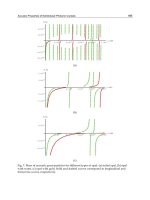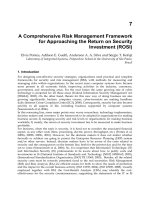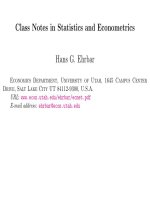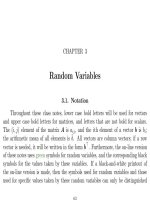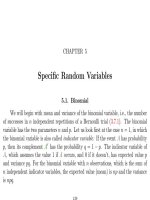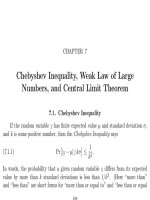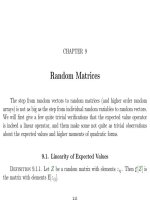Class Notes in Statistics and Econometrics Part 9 pptx
Bạn đang xem bản rút gọn của tài liệu. Xem và tải ngay bản đầy đủ của tài liệu tại đây (404.59 KB, 39 trang )
CHAPTER 17
Causality and Inference
This chapter establishes the connection between critical realism and Holland and
Rubin’s modelling of causality in statistics as explained in [Hol86] and [WM83, pp.
3–25] (and the related paper [LN81] which comes from a Bayesian point of view). A
different approach to causality and inference, [Roy97], is discussed in chapter/section
2.8. Regarding critical realism and econometrics, also [Dow99] s hould be mentioned:
this is written by a Post Keynesian econometrician working in an explicitly realist
framework.
Everyone knows that correlation does not mean causality. Nevertheless, expe-
rience shows that statisticians can on occasion make valid inferences about causal-
ity. It is therefore legitimate to ask: how and under which conditions can causal
473
474 17. CAUSALITY AND INFERENCE
conclusions be drawn from a statistical experiment or a statistical investigation of
nonexperimental data?
Holland starts his discussion with a description of the “logic of association”
(= a flat empirical realism) as opposed to causality (= depth realism). His model
for the “logic of ass ociation” is essentially the conventional mathematical model of
probability by a set U of “all possible outcomes,” which we described and criticized
on p. 12 above.
After this, Rubin describes his own model (developed together with Holland).
Rubin introduces “counterfactual” (or, as Bhaskar would say, “transfactual”) el-
ements since he is not only talking about the value a variable takes for a given
individual, but also the value this variable would have taken for the same individual
if the causing variables (which Rubin also calls “treatments”) had been different.
For simplicity, Holland assumes here that the treatment variable has only two levels:
either the individual receives the treatment, or he/she does not (in which case he/she
belongs to the “control” group). The correlational view would simply measure the
average response of those individuals who receive the treatment, and of those who
don’t. Rubin recognizes in his model that the same individual may or may not be
subject to the treatment, therefore the response variable has two values, one being
the individual’s response if he or she receives the treatment, the other the response
if he or she does not.
17. CAUSALITY AND INFERENCE 475
A third variable indicates who receives the treatment. I.e, he has the “causal in-
dicator” s which can take two values, t (treatment) and c (control), and two variables
y
t
and y
c
, which, evaluated at individual ω, indicate the responses this individual
would give in case he was subject to the treatment, and in case he was or not.
Rubin defines y
t
− y
c
to be the causal effect of treatment t versus the control
c. But this causal effect cannot be observed. We cannot observe how those indi-
viuals who received the treatement would have responded if they had not received
the treatment, despite the fact that this non-actualized response is just as real as
the response which they indeed gave. This is what Holland calls the Fundamental
Problem of Causal Inference.
Problem 225. Rubin excludes race as a cause because the individual cannot do
anything about his or her race. Is this argument justified?
Does this Fundamental Problem mean that causal inference is impossible? Here
are several scenarios in which causal inference is pos sible after all:
• Temporal stability of the response, and transience of the causal effect.
• Unit homogeneity.
• Constant effect, i.e., y
t
(ω) − y
c
(ω) is the same for all ω.
• Independence of the response with respect to the selection process regarding
who gets the treatment.
476 17. CAUSALITY AND INFERENCE
For an e xample of this last case, say
Problem 226. Our universal set U consists of patients who have a certain dis-
ease. We will explore the causal effect of a given treatment with the help of three
events, T , C, and S, the first two of which are counterfactual, compare [Hol86].
These events are defined as follows: T consists of all patients who would recover
if given treatment; C consists of all patients who would recover if not given treat-
ment (i.e., if included in the contro l group). The event S consists of all patients
actually receiving treatment. The average causal effect of the treatment is defined as
Pr[T ] − Pr[C].
• a. 2 points Show that
Pr[T ] = Pr[T |S] Pr[S] + Pr[T |S
](1 − Pr[S])(17.0.6)
and that
Pr[C] = Pr[C|S] Pr[S] + Pr[C|S
](1 − Pr[S])(17.0.7)
Which of these pro babilities can be estimated as the frequencies of observable outcomes
and which cannot?
Answer. This is a direct application of (2.7.9). The problem here is that for all ω ∈ C, i.e.,
for those patients who do not receive trea tme nt, we do not know whether they would have recovered
17. CAUSALITY AND INFERENCE 477
if given treatment, and for all ω ∈ T , i.e., for those patients who do receive treatment, we do not
know whether they would have recovered if not given treatment. In other words, neither Pr[T |S]
nor E[C|S
] can be estimated as the frequencies of observable outcomes.
• b. 2 points Assume now that S is independent of T and C, because the subjects
are assigned randomly to treatment or control. How can this be used to estimate those
elements in the equations (17.0.6) and (17.0.7) which could not be estimated before?
Answer. In this case, Pr[T |S] = Pr[T |S
] and Pr[C|S
] = Pr[C|S]. Therefore, the average
causal effect can be simplified as follows:
Pr[T ] − Pr[C] = Pr[T |S] Pr[S] + Pr[T |S
](1 − Pr[S]) − Pr[C|S] Pr[S] + Pr[C|S
](1 − Pr[S])
= Pr[T |S] Pr[S] + Pr[T |S](1 − Pr[S]) − Pr[C|S
] Pr[S] + Pr[C|S
](1 − Pr[S])
= Pr[T |S] − Pr[C|S
](17.0.8)
• c. 2 points Why were all these calculations necessary? Could one not have
defined from the beginning that the causal effect of the treatment is Pr[T |S]−Pr[C|S
]?
Answer. Pr[T |S] − Pr[C|S
] is only the empirical difference in recovery frequencies between
those who receive treatment an d those who do not. It is always possible to measure these differences,
but these differences are not necessarily due to the treatment but may be due to other reasons.
478 17. CAUSALITY AND INFERENCE
The main message of the paper is therefore: before drawing causal conclusions
one should acertain whether one of these conditions apply which make causal con-
clusions possible.
In the rest of the paper, Holland compares his approach with other approaches.
Supp es ’s definitions of causality are interesting:
• If r < s denote two time values, event C
r
is a prima facie cause of E
s
iff
Pr[E
s
|C
r
] > Pr[E
s
].
• C
r
is a spurious cause of E
s
iff it is a prima facie cause of E
s
and for some
q < r < s there is an event D
q
so that Pr[E
s
|C
r
, D
q
] = Pr[E
s
|D
q
] and
Pr[E
s
|C
r
, D
q
] ≥ Pr[E
s
|C
r
].
• Event C
r
is a genuine cause of E
s
iff it is a prima facie but not a spurious
cause.
This is quite different than Rubin’s analysis. Suppes concentrates on the causes of a
given effect, not the effects of a given cause. Suppes has a Popperian falsificationist
view: a hypothesis is good if one cannot falsify it, while Holland has the depth-realist
view which says that the empirical is only a small part of reality, and which looks at
the underlying mechanisms.
Problem 227. Construct an example of a probability field with a spurious cause.
17. CAUSALITY AND INFERENCE 479
Granger causality (see chapter/section 67.2.1) is based on the idea: knowing
a cause ought to improve our ability to predict. It is more appropriate to speak
here of “noncausality” instead of causality: a variable does not cause another if
knowing that variable does not improve our ability to predict the other variable.
Granger formulates his theory in terms of a specific predictor, the BLUP, while
Holland extends it to all predictors. Granger works on it in a time series framework,
while Holland gives a more general formulation. Holland’s formulation strips off the
unnecessary detail in order to ge t at the essence of things. Holland defines: x is not
a Granger cause of y relative to the information in z (which in the timeseries context
contains the past values of y) if and only if x and y are conditionally independent
given z. Problem 40 explains why this can be tested by testing predictive power.
CHAPTER 18
Mean-Variance Analysis in the Linear Model
In the present chapter, the only distributional assumptions are that means and
variances exist. (From this follows that also the covariances exist).
18.1. Three Versions of the Linear Model
As background reading please read [CD97, Chapter 1].
Following [JHG
+
88, Chapter 5], we will start with three different linear statisti-
cal models. Model 1 is the simplest estimation problem already familiar from chapter
12, with n independent observations from the same distribution, call them y
1
, . . . , y
n
.
The only thing known about the distribution is that mean and variance exist, call
them µ and σ
2
. In order to write this as a special case of the “linear model,” define
481
482 18. MEAN-VARIANCE ANALYSIS IN THE LINEAR MODEL
ε
i
= y
i
−µ, and define the vectors y =
y
1
y
2
··· y
n
, ε
ε
ε =
ε
1
ε
2
··· ε
n
,
and ι =
1 1 ··· 1
. Then one can write the model in the form
(18.1.1)
y = ιµ + ε
ε
ε ε
ε
ε ∼ (o, σ
2
I)
The notation ε
ε
ε ∼ (o, σ
2
I) is shorthand for
E
[ε
ε
ε] = o (the null vector) and
V
[ε
ε
ε] = σ
2
I
(σ
2
times the identity matrix, which has 1’s in the diagonal and 0’s elsewhere). µ is
the deterministic part of all the y
i
, and ε
i
is the random part.
Model 2 is “simple regression” in which the deterministic part µ is not constant
but is a function of the nonrandom variable x. The assumption here is that this
function is differentiable and can, in the range of the variation of the data, be ap-
proximated by a linear function [Tin51, pp. 19–20]. I.e., each element of y is a
constant α plus a constant multiple of the corresponding element of the nonrandom
vector x plus a random error term: y
t
= α + x
t
β + ε
t
, t = 1, . . . , n. This can be
written as
(18.1.2)
y
1
.
.
.
y
n
=
1
.
.
.
1
α +
x
1
.
.
.
x
n
β +
ε
1
.
.
.
ε
n
=
1 x
1
.
.
.
.
.
.
1 x
n
α
β
+
ε
1
.
.
.
ε
n
or
(18.1.3) y = Xβ + ε
ε
ε ε
ε
ε ∼ (o, σ
2
I)
18.1. THREE VERSIONS OF THE LINEAR MODEL 483
Problem 228. 1 point Compute the matrix product
1 2 5
0 3 1
4 0
2 1
3 8
Answer.
1 2 5
0 3 1
4 0
2 1
3 8
=
1 · 4 + 2 · 2 + 5 · 3 1 · 0 + 2 · 1 + 5 · 8
0 · 4 + 3 · 2 + 1 · 3 0 · 0 + 3 · 1 + 1 · 8
=
23 42
9 11
If the systematic part of y depends on more than one variable, then one needs
multiple regression, model 3. Mathematically, multiple regression has the same form
(18.1.3), but this time X is arbitrary (except for the restriction that all its columns
are linearly independent). Model 3 has Models 1 and 2 as special cases.
Multiple regression is also used to “correct for” disturbing influences. Let me
explain. A functional relationship, which makes the system atic part of y dependent
on some other variable x will usually only hold if other relevant influences are kept
constant. If those other influences vary, then they may affect the form of this func-
tional relation. For instance, the marginal propensity to consume may be affected
by the interest rate, or the unemployment rate. This is why some econometricians
484 18. MEAN-VARIANCE ANALYSIS IN THE LINEAR MODEL
(Hendry) advocate that one should start with an “encompassing” model with many
explanatory variables and then narrow the specification down by hypothesis tests.
Milton Friedman, by contrast, is very suspicious about multiple regressions, and
argues in [FS91, pp. 48/9] against the encompassing approach.
Friedman does not give a theoretical argument but argues by an example from
Chemistry. Perhaps one can say that the variations in the other influences may have
more serious implications than just modifying the form of the functional relation:
they may destroy this functional relation altogether, i.e., prevent any systematic or
predictable behavior.
observed unobserved
random y ε
ε
ε
nonrandom X β, σ
2
18.2. Ordinary Least Squares
In the model y = Xβ + ε
ε
ε, where ε
ε
ε ∼ (o, σ
2
I), the OLS-estimate
ˆ
β is defined to
be that value β =
ˆ
β which minimizes
(18.2.1) SSE = (y − Xβ)
(y − Xβ) = y
y − 2y
Xβ + β
X
Xβ.
Problem 184 shows that in model 1, this principle yields the arithmetic mean.
18.2. ORDINARY LEAST SQUARES 485
Problem 229. 2 points Prove that, if one predicts a random variable y by a
constant a, the constant which gives the best MSE is a = E[y], and the best MSE one
can get is var[y].
Answer. E[(y − a)
2
] = E[y
2
] − 2a E[y] + a
2
. Differentiate with respect to a and set zero to
get a = E[y]. One can also differentiate first and then take expected value: E[2(y −a)] = 0.
We will solve this minimization problem using the first-order conditions in vector
notation. As a preparation, you should read the beginning of Appendix C about
matrix differentiation and the connection b etween matrix differentiation and the
Jacobian matrix of a vector function. All you need at this point is the two equations
(C.1.6) and (C.1.7). The chain rule (C.1.23) is enlightening but not strictly necessary
for the present derivation.
The matrix differentiation rules (C.1.6) and (C.1.7) allow us to differentiate
(18.2.1) to get
(18.2.2) ∂SSE/∂β
= −2y
X + 2β
X
X.
Transpose it (because it is notationally simpler to have a relationship between column
vectors), set it zero while at the same time replacing β by
ˆ
β, and divide by 2, to get
the “normal equation”
(18.2.3) X
y = X
X
ˆ
β.
486 18. MEAN-VARIANCE ANALYSIS IN THE LINEAR MODEL
Due to our assumption that all columns of X are linearly independent, X
X has
an inverse and one can premultiply both sides of (18.2.3) by (X
X)
−1
:
(18.2.4)
ˆ
β = (X
X)
−1
X
y.
If the columns of X are not linearly independent, then (18.2.3) has more than one
solution, and the normal equation is also in this case a necessary and sufficient
condition for
ˆ
β to minimize the SSE (proof in Problem 232).
Problem 230. 4 points Using the matrix differentiation rules
∂w
x/∂x
= w
(18.2.5)
∂x
Mx/∂x
= 2x
M(18.2.6)
for symmetric M , compute the least-squares estimate
ˆ
β which minimizes
(18.2.7) SSE = (y − Xβ)
(y − Xβ)
You are allowed to assume that X
X has an inverse.
Answer. First you have to multiply out
(18.2.8) (y − Xβ)
(y − Xβ) = y
y − 2y
Xβ + β
X
Xβ.
The matrix differentiation rules (18.2.5) and (18.2.6) allow us to differentiate (18.2.8) to get
(18.2.9) ∂SSE/∂β
= −2y
X + 2β
X
X.
18.2. ORDINARY LEAST SQUARES 487
Transpose it (because it is notationally simpler to have a relationship between col umn vectors), set
it zero while at the same time replacing β by
ˆ
β, and divide by 2, to get the “normal equation ”
(18.2.10) X
y = X
X
ˆ
β.
Since X
X has an inverse, one can premultiply both sides of (18.2.10) by (X
X)
−1
:
(18.2.11)
ˆ
β = (X
X)
−1
X
y.
Problem 231. 2 points Show the following: if the columns of X are linearly
independent, then X
X has an inverse. (X itself is not necessarily square.) In your
proof you may use the following criteria: the columns of X are linearly independent
(this is also called: X has full column rank) if and only if Xa = o implies a = o.
And a square matrix has an inverse if and only if its columns are linearly independent.
Answer. We have to show that any a which satisfies X
Xa = o is itself the null vector.
From X
Xa = o follows a
X
Xa = 0 which can also be written Xa
2
= 0. Therefore Xa = o,
and since the columns of X are linearly independent, this implies a = o.
Problem 232. 3 points In this Problem we do not assume that X has full column
rank, it may be arbitrary.
• a. The normal equation (18.2.3) has always at least one solution. Hint: you
are allowed to use, without proof, equation (A.3.3) in the mathematical appendix.
488 18. MEAN-VARIANCE ANALYSIS IN THE LINEAR MODEL
Answer. With this hint it is easy:
ˆ
β = (X
X)
−
X
y is a solution.
• b. If
ˆ
β satisfies the normal equation and β is an arbitrary vector, then
(18.2.12) (y − Xβ)
(y − Xβ) = (y − X
ˆ
β)
(y − X
ˆ
β) + (β −
ˆ
β)
X
X(β −
ˆ
β).
Answer. This is true even if X has deficient rank, and it will be sh own here in this general
case. To prove (18.2.12), write (18.2.1) as SSE =
(y −X
ˆ
β)−X(β −
ˆ
β)
(y −X
ˆ
β)−X(β −
ˆ
β)
;
since
ˆ
β satisfies (18.2.3), the cross product terms disappear.
• c. Conclude from this that t he normal equation is a necessary and sufficient
condition characterizing the values
ˆ
β minimizing the sum of squared errors (18.2.12).
Answer. (18.2.12) shows that the normal equations are sufficient. For necessity of the normal
equations let
ˆ
β be an arbitrary solution of the normal equation, we have seen that there is always
at least one. Given
ˆ
β, it follows from (18.2.12) that for any solution β
∗
of the minimization,
X
X(β
∗
−
ˆ
β) = o. Use (18.2.3) to replace (X
X)
ˆ
β by X
y to get X
Xβ
∗
= X
y.
It is customary to use the notation X
ˆ
β = ˆy for the so-called fitted values, which
are the estimates of the vector of means η = Xβ. Geometrically, ˆy is the orthogonal
projection of y on the space spanned by the columns of X. See Theorem A.6.1 about
projection matrices.
The vector of differences between the actual and the fitted values is called the
vector of “residuals” ˆε = y − ˆy. The residuals are “predictors” of the actual (but
18.2. ORDINARY LEAST SQUARES 489
unobserved) values of the disturbance vector ε
ε
ε. An estimator of a random magnitude
is usually called a “predictor,” but in the linear model estimation and prediction are
treated on the same footing, therefore it is not necessary to distinguish between the
two.
You should understand the difference between disturbances and residuals, and
between the two decompositions
(18.2.13) y = Xβ + ε
ε
ε = X
ˆ
β + ˆε
Problem 233. 2 points Assume that X has full column rank. Show that ˆε = M y
where M = I −X(X
X)
−1
X
. Show that M is symmetric and idempotent.
Answer. By definition, ˆε = y − X
ˆ
β = y − X(X
X)
−1
Xy =
I − X(X
X)
−1
X
y. Idem-
potent, i.e. MM = M :
MM =
I − X(X
X)
−1
X
I − X(X
X)
−1
X
= I − X(X
X)
−1
X
− X(X
X)
−1
X
+ X(X
X)
−1
X
X(X
X)
−1
X
= I − 2X(X
X)
−1
X
+ X(X
X)
−1
X
= I − X(X
X)
−1
X
= M
(18.2.14)
Problem 234. Assume X has full column rank. Define M = I−X(X
X)
−1
X
.
• a. 1 point Show that the space M projects on is the space orthogonal to all
columns in X, i.e., M q = q if and only if X
q = o.
490 18. MEAN-VARIANCE ANALYSIS IN THE LINEAR MODEL
Answer. X
q = o clearly implies M q = q . Conversely, M q = q implies X(X
X)
−1
X
q =
o. Premultiply this by X
to get X
q = o.
• b. 1 point Show that a vector q lies in the range space of X, i.e., the space
spanned by the columns of X, if and only if M q = o. In other w ords, {q : q = Xa
for some a} = {q : M q = o}.
Answer. First assume M q = o. This means q = X(X
X)
−1
X
q = Xa with a =
(X
X)
−1
X
q. Conversely, if q = Xa then M q = M Xa = Oa = o.
Problem 235. In 2-dimensional space, write down the projection matrix on the
diagonal line y = x (call it E), and compute Ez for the three vectors a = [
2
1
],
b = [
2
2
], and c = [
3
2
]. Draw these vectors and their projections.
Assume we have a dependent variable y and two regressors x
1
and x
2
, e ach with
15 observations. Then one can visualize the data either as 15 points in 3-dimensional
space (a 3-dimensional scatter plot), or 3 points in 15-dimensional space. In the
first case , each point corresponds to an observation, in the second case, each point
corresponds to a variable. In this latter case the points are usually represented
as vectors. You only have 3 vectors, but each of these vectors is a vector in 15-
dimensional space. But you do not have to draw a 15-dimensional space to draw
these vectors; these 3 vectors span a 3-dimensional subspace, and ˆy is the projection
of the vector y on the space spanned by the two regressors not only in the original
18.2. ORDINARY LEAST SQUARES 491
15-dimensional space, but already in this 3-dimensional subspace. In other words,
[DM93, Figure 1.3] is valid in all dimensions! In the 15-dimensional space, each
dimension represents one observation. In the 3-dimensional subspace, this is no
longer true.
Problem 236. “Simple regression” is regression with an intercept and one ex-
planatory variable only, i.e.,
(18.2.15) y
t
= α + βx
t
+ ε
t
Here X =
ι x
and β =
α β
. Evaluate (18.2.4) to get the following formulas
for
ˆ
β =
ˆα
ˆ
β
:
ˆα =
x
2
t
y
t
−
x
t
x
t
y
t
n
x
2
t
− (
x
t
)
2
(18.2.16)
ˆ
β =
n
x
t
y
t
−
x
t
y
t
n
x
2
t
− (
x
t
)
2
(18.2.17)
Answer.
(18.2.18) X
X =
ι
x
ι x
=
ι
ι ι
x
x
ι x
x
=
n
x
t
x
t
x
2
t
492 18. MEAN-VARIANCE ANALYSIS IN THE LINEAR MODEL
(18.2.19) X
X
−1
=
1
n
x
2
t
− (
x
t
)
2
x
2
t
−
x
t
−
x
t
n
(18.2.20) X
y =
ι
y
x
y
=
y
t
x
i
y
t
Therefore (X
X)
−1
X
y gives equations (18.2.16) and (18.2.17).
Problem 237. Show that
(18.2.21)
n
t=1
(x
t
− ¯x)(y
t
− ¯y) =
n
t=1
x
t
y
t
− n¯x¯y
(Note, as explained in [DM93, pp. 27/8] or [Gre97, Section 5.4.1], that the left
hand side is computationally much more stable than the right.)
Answer. Simply multiply out.
Problem 238. Show that (18.2.17) and (18.2.16) can also be written as follows:
ˆ
β =
(x
t
− ¯x)(
y
t
− ¯y)
(x
t
− ¯x)
2
(18.2.22)
ˆα = ¯y −
ˆ
β¯x(18.2.23)
18.2. ORDINARY LEAST SQUARES 493
Answer. Using
x
i
= n¯x and
y
i
= n¯y in (18.2.17), it can be written as
(18.2.24)
ˆ
β =
x
t
y
t
− n¯x¯y
x
2
t
− n¯x
2
Now apply Problem 237 to the numerator of (18.2.24), and Problem 237 with y = x to the denom-
inator, to get (18.2.22).
To prove equation (18.2.23) for ˆα, let us work backwards and plug (18.2.24) into the righthand
side of (18.2.23):
(18.2.25) ¯y − ¯x
ˆ
β =
¯y
x
2
t
− ¯yn¯x
2
− ¯x
x
t
y
t
+ n¯x¯x¯y
x
2
t
− n¯x
2
The second and the fourth term in the numerator cancel out, and what remains can be shown to
be equal to (18.2.16).
Problem 239. 3 points Show that in the simple regression model, the fitted
regression line can be written in the form
(18.2.26) ˆy
t
= ¯y +
ˆ
β(x
t
− ¯x).
From this follows in particular that the fitted regression line always goes through the
point ¯x, ¯y.
494 18. MEAN-VARIANCE ANALYSIS IN THE LINEAR MODEL
Answer. Follows immediately if one plugs (18.2.23) into the defining equation ˆy
t
= ˆα +
ˆ
βx
t
.
Formulas (18.2.22) and (18.2.23) are interesting because they express the regres-
sion coefficients in terms of the sample means and covariances. Problem 240 derives
the properties of the population equivalents of these formulas:
Problem 240. Given two random variables x and y with finite variances, and
var[x] > 0. You know the expected values, variances and covariance of x and y, and
you observe x, but y is unobserved. This question explores the properties of the Best
Linear Unbiased Predictor (BLUP) of y in this situation.
• a. 4 points Give a direct proof of the following, which is a special case of theorem
27.1.1: If you want to predict y by an affine expression of the form a+bx, you will get
the lowest mean squared error MSE with b = cov[x, y]/ var[x] and a = E[y] − b E[x].
Answer. The MSE is variance plus squared bias (s ee e.g. pr oblem 193), therefore
(18.2.27) MSE[a + bx; y] = var[a + bx − y] + (E[a + bx − y])
2
= var[bx −y] + (a − E[y] + b E[x])
2
.
Therefore we choose a so that the second term is zero, and then you only have to minimize the first
term with resp ect to b. Since
(18.2.28) var[bx − y] = b
2
var[x] − 2b cov[x, y] + var[y]
18.2. ORDINARY LEAST SQUARES 495
the first order condition is
(18.2.29) 2b var[x] − 2 cov[x, y] = 0
• b. 2 points For the first-order conditions you needed the partial derivatives
∂
∂a
E[(y −a−bx)
2
] and
∂
∂b
E[(y −a−bx)
2
]. It is also possible, and probably shorter, to
interchange taking expected value and partial derivative, i.e., to compute E
∂
∂a
(y −
a − bx)
2
and E
∂
∂b
(y − a − bx)
2
and set those zero. Do the above proof in this
alternative fashion.
Answer. E
∂
∂a
(y −a−bx)
2
= −2 E[y−a−bx] = −2(E[y]−a−b E[x]). Setting this zero gives
the formula for a. Now E
∂
∂b
(y − a − bx)
2
= −2 E[x(y − a − bx)] = −2(E[xy] − a E[x] − b E[x
2
]).
Setting this zero gives E[xy] − a E[x] − b E[x
2
] = 0. Plug in formula for a and solve for b:
(18.2.30) b =
E[xy] − E[x] E[y]
E[x
2
] − (E[x])
2
=
cov[x, y]
var[x]
.
• c. 2 points Compute the MSE of this predictor.
496 18. MEAN-VARIANCE ANALYSIS IN THE LINEAR MODEL
Answer. If one plugs the optimal a into (18.2.27), this just annulls the last term of (18.2.27)
so that the MSE is given by (18.2.28). If one plugs the optimal b = cov[x, y]/ var[x] into (18.2.28),
one gets
MSE =
cov[x, y]
var[x]
2
var[x] − 2
(cov[x, y])
var[x]
cov[x, y] + var[x](18.2.31)
= var[y] −
(cov[x, y])
2
var[x]
.(18.2.32)
• d. 2 points Show that the prediction error is uncorrelated with the observed x.
Answer.
(18.2.33) cov[x, y − a − bx] = cov[x, y] − a cov[x, x] = 0
• e. 4 points If var[x] = 0, the quotient cov[x, y]/ var[x] can no longer be formed,
but if you replace the inverse by the g-inverse, so that the above formula becomes
(18.2.34) b = cov[x, y](var[x])
−
then it always gives the minimum MSE predictor, whether or not var[x] = 0, and
regardless of which g-inverse you use (in case there are more than one). To prove this,
you need to answer the following four questions: (a) what is the BLUP if var[x] = 0?
18.2. ORDINARY LEAST SQUARES 497
(b) what is the g-inverse of a nonzero scalar? (c) w hat is the g-inverse of the scalar
number 0? (d) if var[x] = 0, what do we know about cov[x, y]?
Answer. (a) If var[x] = 0 then x = µ almost surely, therefore the observation of x does not
give us any new information. The BLUP of y is ν in this case, i.e., the above formula ho lds with
b = 0.
(b) The g-inverse of a nonzero scalar is simply its inverse.
(c) Every scalar is a g-inverse of the scalar 0.
(d) if var[x] = 0, then cov[x, y] = 0.
Therefore pick a g-inverse 0, an arbitrary number will do, call it c. Then formula (18.2.34)
says b = 0 · c = 0.
Problem 241. 3 points Carefully state the specifications of the random variables
involved in the linear regression model. How does the model in Problem 240 differ
from the linear regression model? What do they have in common?
Answer. In the regression model, you have several observations, in the other model only one.
In the regression model, the x
i
are nonrandom, only the y
i
are random, in the other model both
x and y are random. In the regression model, the expected value of the y
i
are not fully known,
in the other model the expected values of both x and y are fully known. Both models have in
common that the second moments are known only up to an unknown factor. Both models have in
common that only first and second moments need to be known, and that they restrict themselves
to linear estimators, and that the criterion function is the MSE (the regression model minimaxes
it, but the other model minimizes it since there is no unknown parameter whose value one has to



